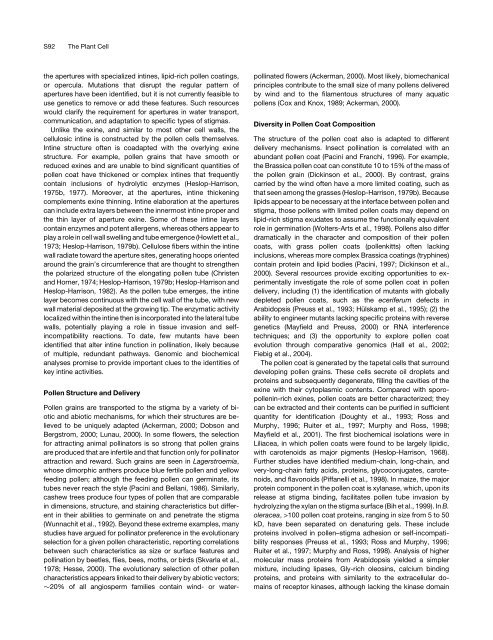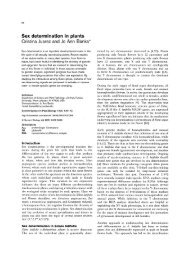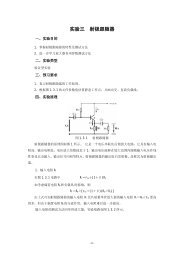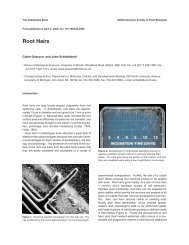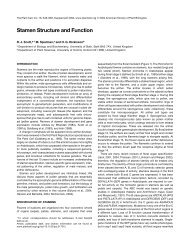Pollen and Stigma Structure and Function: The Role of Diversity in ...
Pollen and Stigma Structure and Function: The Role of Diversity in ...
Pollen and Stigma Structure and Function: The Role of Diversity in ...
Create successful ePaper yourself
Turn your PDF publications into a flip-book with our unique Google optimized e-Paper software.
S92<br />
<strong>The</strong> Plant Cell<br />
the apertures with specialized <strong>in</strong>t<strong>in</strong>es, lipid-rich pollen coat<strong>in</strong>gs,<br />
or opercula. Mutations that disrupt the regular pattern <strong>of</strong><br />
apertures have been identified, but it is not currently feasible to<br />
use genetics to remove or add these features. Such resources<br />
would clarify the requirement for apertures <strong>in</strong> water transport,<br />
communication, <strong>and</strong> adaptation to specific types <strong>of</strong> stigmas.<br />
Unlike the ex<strong>in</strong>e, <strong>and</strong> similar to most other cell walls, the<br />
cellulosic <strong>in</strong>t<strong>in</strong>e is constructed by the pollen cells themselves.<br />
Int<strong>in</strong>e structure <strong>of</strong>ten is coadapted with the overly<strong>in</strong>g ex<strong>in</strong>e<br />
structure. For example, pollen gra<strong>in</strong>s that have smooth or<br />
reduced ex<strong>in</strong>es <strong>and</strong> are unable to b<strong>in</strong>d significant quantities <strong>of</strong><br />
pollen coat have thickened or complex <strong>in</strong>t<strong>in</strong>es that frequently<br />
conta<strong>in</strong> <strong>in</strong>clusions <strong>of</strong> hydrolytic enzymes (Heslop-Harrison,<br />
1975b, 1977). Moreover, at the apertures, <strong>in</strong>t<strong>in</strong>e thicken<strong>in</strong>g<br />
complements ex<strong>in</strong>e th<strong>in</strong>n<strong>in</strong>g. Int<strong>in</strong>e elaboration at the apertures<br />
can <strong>in</strong>clude extra layers between the <strong>in</strong>nermost <strong>in</strong>t<strong>in</strong>e proper <strong>and</strong><br />
the th<strong>in</strong> layer <strong>of</strong> aperture ex<strong>in</strong>e. Some <strong>of</strong> these <strong>in</strong>t<strong>in</strong>e layers<br />
conta<strong>in</strong> enzymes <strong>and</strong> potent allergens, whereas others appear to<br />
play a role <strong>in</strong> cell wall swell<strong>in</strong>g <strong>and</strong> tube emergence (Howlett et al.,<br />
1973; Heslop-Harrison, 1979b). Cellulose fibers with<strong>in</strong> the <strong>in</strong>t<strong>in</strong>e<br />
wall radiate toward the aperture sites, generat<strong>in</strong>g hoops oriented<br />
around the gra<strong>in</strong>’s circumference that are thought to strengthen<br />
the polarized structure <strong>of</strong> the elongat<strong>in</strong>g pollen tube (Christen<br />
<strong>and</strong> Horner, 1974; Heslop-Harrison, 1979b; Heslop-Harrison <strong>and</strong><br />
Heslop-Harrison, 1982). As the pollen tube emerges, the <strong>in</strong>t<strong>in</strong>e<br />
layer becomes cont<strong>in</strong>uous with the cell wall <strong>of</strong> the tube, with new<br />
wall material deposited at the grow<strong>in</strong>g tip. <strong>The</strong> enzymatic activity<br />
localized with<strong>in</strong> the <strong>in</strong>t<strong>in</strong>e then is <strong>in</strong>corporated <strong>in</strong>to the lateral tube<br />
walls, potentially play<strong>in</strong>g a role <strong>in</strong> tissue <strong>in</strong>vasion <strong>and</strong> self<strong>in</strong>compatibility<br />
reactions. To date, few mutants have been<br />
identified that alter <strong>in</strong>t<strong>in</strong>e function <strong>in</strong> poll<strong>in</strong>ation, likely because<br />
<strong>of</strong> multiple, redundant pathways. Genomic <strong>and</strong> biochemical<br />
analyses promise to provide important clues to the identities <strong>of</strong><br />
key <strong>in</strong>t<strong>in</strong>e activities.<br />
<strong>Pollen</strong> <strong>Structure</strong> <strong>and</strong> Delivery<br />
<strong>Pollen</strong> gra<strong>in</strong>s are transported to the stigma by a variety <strong>of</strong> biotic<br />
<strong>and</strong> abiotic mechanisms, for which their structures are believed<br />
to be uniquely adapted (Ackerman, 2000; Dobson <strong>and</strong><br />
Bergstrom, 2000; Lunau, 2000). In some flowers, the selection<br />
for attract<strong>in</strong>g animal poll<strong>in</strong>ators is so strong that pollen gra<strong>in</strong>s<br />
are produced that are <strong>in</strong>fertile <strong>and</strong> that function only for poll<strong>in</strong>ator<br />
attraction <strong>and</strong> reward. Such gra<strong>in</strong>s are seen <strong>in</strong> Lagerstroemia,<br />
whose dimorphic anthers produce blue fertile pollen <strong>and</strong> yellow<br />
feed<strong>in</strong>g pollen; although the feed<strong>in</strong>g pollen can germ<strong>in</strong>ate, its<br />
tubes never reach the style (Pac<strong>in</strong>i <strong>and</strong> Bellani, 1986). Similarly,<br />
cashew trees produce four types <strong>of</strong> pollen that are comparable<br />
<strong>in</strong> dimensions, structure, <strong>and</strong> sta<strong>in</strong><strong>in</strong>g characteristics but different<br />
<strong>in</strong> their abilities to germ<strong>in</strong>ate on <strong>and</strong> penetrate the stigma<br />
(Wunnachit et al., 1992). Beyond these extreme examples, many<br />
studies have argued for poll<strong>in</strong>ator preference <strong>in</strong> the evolutionary<br />
selection for a given pollen characteristic, report<strong>in</strong>g correlations<br />
between such characteristics as size or surface features <strong>and</strong><br />
poll<strong>in</strong>ation by beetles, flies, bees, moths, or birds (Skvarla et al.,<br />
1978; Hesse, 2000). <strong>The</strong> evolutionary selection <strong>of</strong> other pollen<br />
characteristics appears l<strong>in</strong>ked to their delivery by abiotic vectors;<br />
20% <strong>of</strong> all angiosperm families conta<strong>in</strong> w<strong>in</strong>d- or waterpoll<strong>in</strong>ated<br />
flowers (Ackerman, 2000). Most likely, biomechanical<br />
pr<strong>in</strong>ciples contribute to the small size <strong>of</strong> many pollens delivered<br />
by w<strong>in</strong>d <strong>and</strong> to the filamentous structures <strong>of</strong> many aquatic<br />
pollens (Cox <strong>and</strong> Knox, 1989; Ackerman, 2000).<br />
<strong>Diversity</strong> <strong>in</strong> <strong>Pollen</strong> Coat Composition<br />
<strong>The</strong> structure <strong>of</strong> the pollen coat also is adapted to different<br />
delivery mechanisms. Insect poll<strong>in</strong>ation is correlated with an<br />
abundant pollen coat (Pac<strong>in</strong>i <strong>and</strong> Franchi, 1996). For example,<br />
the Brassica pollen coat can constitute 10 to 15% <strong>of</strong> the mass <strong>of</strong><br />
the pollen gra<strong>in</strong> (Dick<strong>in</strong>son et al., 2000). By contrast, gra<strong>in</strong>s<br />
carried by the w<strong>in</strong>d <strong>of</strong>ten have a more limited coat<strong>in</strong>g, such as<br />
that seen among the grasses (Heslop-Harrison, 1979b). Because<br />
lipids appear to be necessary at the <strong>in</strong>terface between pollen <strong>and</strong><br />
stigma, those pollens with limited pollen coats may depend on<br />
lipid-rich stigma exudates to assume the functionally equivalent<br />
role <strong>in</strong> germ<strong>in</strong>ation (Wolters-Arts et al., 1998). <strong>Pollen</strong>s also differ<br />
dramatically <strong>in</strong> the character <strong>and</strong> composition <strong>of</strong> their pollen<br />
coats, with grass pollen coats (pollenkitts) <strong>of</strong>ten lack<strong>in</strong>g<br />
<strong>in</strong>clusions, whereas more complex Brassica coat<strong>in</strong>gs (tryph<strong>in</strong>es)<br />
conta<strong>in</strong> prote<strong>in</strong> <strong>and</strong> lipid bodies (Pac<strong>in</strong>i, 1997; Dick<strong>in</strong>son et al.,<br />
2000). Several resources provide excit<strong>in</strong>g opportunities to experimentally<br />
<strong>in</strong>vestigate the role <strong>of</strong> some pollen coat <strong>in</strong> pollen<br />
delivery, <strong>in</strong>clud<strong>in</strong>g (1) the identification <strong>of</strong> mutants with globally<br />
depleted pollen coats, such as the eceriferum defects <strong>in</strong><br />
Arabidopsis (Preuss et al., 1993; Hülskamp et al., 1995); (2) the<br />
ability to eng<strong>in</strong>eer mutants lack<strong>in</strong>g specific prote<strong>in</strong>s with reverse<br />
genetics (Mayfield <strong>and</strong> Preuss, 2000) or RNA <strong>in</strong>terference<br />
techniques; <strong>and</strong> (3) the opportunity to explore pollen coat<br />
evolution through comparative genomics (Hall et al., 2002;<br />
Fiebig et al., 2004).<br />
<strong>The</strong> pollen coat is generated by the tapetal cells that surround<br />
develop<strong>in</strong>g pollen gra<strong>in</strong>s. <strong>The</strong>se cells secrete oil droplets <strong>and</strong><br />
prote<strong>in</strong>s <strong>and</strong> subsequently degenerate, fill<strong>in</strong>g the cavities <strong>of</strong> the<br />
ex<strong>in</strong>e with their cytoplasmic contents. Compared with sporopollen<strong>in</strong>-rich<br />
ex<strong>in</strong>es, pollen coats are better characterized; they<br />
can be extracted <strong>and</strong> their contents can be purified <strong>in</strong> sufficient<br />
quantity for identification (Doughty et al., 1993; Ross <strong>and</strong><br />
Murphy, 1996; Ruiter et al., 1997; Murphy <strong>and</strong> Ross, 1998;<br />
Mayfield et al., 2001). <strong>The</strong> first biochemical isolations were <strong>in</strong><br />
Liliacea, <strong>in</strong> which pollen coats were found to be largely lipidic,<br />
with carotenoids as major pigments (Heslop-Harrison, 1968).<br />
Further studies have identified medium-cha<strong>in</strong>, long-cha<strong>in</strong>, <strong>and</strong><br />
very-long-cha<strong>in</strong> fatty acids, prote<strong>in</strong>s, glycoconjugates, carotenoids,<br />
<strong>and</strong> flavonoids (Piffanelli et al., 1998). In maize, the major<br />
prote<strong>in</strong> component <strong>in</strong> the pollen coat is xylanase, which, upon its<br />
release at stigma b<strong>in</strong>d<strong>in</strong>g, facilitates pollen tube <strong>in</strong>vasion by<br />
hydrolyz<strong>in</strong>g the xylan on the stigma surface (Bih et al., 1999). In B.<br />
oleracea, >100 pollen coat prote<strong>in</strong>s, rang<strong>in</strong>g <strong>in</strong> size from 5 to 50<br />
kD, have been separated on denatur<strong>in</strong>g gels. <strong>The</strong>se <strong>in</strong>clude<br />
prote<strong>in</strong>s <strong>in</strong>volved <strong>in</strong> pollen–stigma adhesion or self-<strong>in</strong>compatibility<br />
responses (Preuss et al., 1993; Ross <strong>and</strong> Murphy, 1996;<br />
Ruiter et al., 1997; Murphy <strong>and</strong> Ross, 1998). Analysis <strong>of</strong> higher<br />
molecular mass prote<strong>in</strong>s from Arabidopsis yielded a simpler<br />
mixture, <strong>in</strong>clud<strong>in</strong>g lipases, Gly-rich oleos<strong>in</strong>s, calcium b<strong>in</strong>d<strong>in</strong>g<br />
prote<strong>in</strong>s, <strong>and</strong> prote<strong>in</strong>s with similarity to the extracellular doma<strong>in</strong>s<br />
<strong>of</strong> receptor k<strong>in</strong>ases, although lack<strong>in</strong>g the k<strong>in</strong>ase doma<strong>in</strong>


